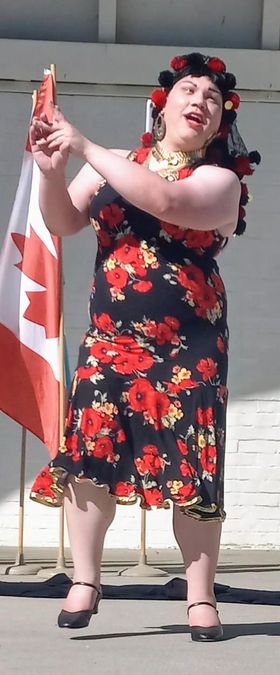By Columbia Strawberry Cunha Mahmoud Reda created a lot of things in his lifetime. Farida Fahmy was his muse and has made it well known that they danced as one at times. The marvelous tableaux Mahmoud had created is still a time-honored tradition today in Egypt. With all traditions comes a territory that becomes misrepresented once it goes abroad. This has happened many times with Egyptian culture.
First off, let me say Reda’s work was never meant to be folkloric as we may think of folkloric
dance. The dances were fused with acrobatics and Soviet Union Ballet. This means it was a form of fusion dance in its heyday; this same concept was used for Amalia Hernanadez’s Ballet Folklorico de Mexico. Like Hernandez, Reda wanted to create a modern dance from Egyptian Folklore. The Bint al- Balad, or Daughter of the Country, was no exception to this rule. This all started with the Erk Soos tableaux. Farida played the Bint al-Balad that came on with a millayah and a very short dress that was modernized. This woman buys herself a drink and flirts with the vendor. They spin with glee until he accidentally spills the drink on her. She gets as angry as a bull in a bullfight and throws her millayah and kicks off her mules. She scolds him with her body language.

This is the first time Egypt saw this character and was the basis for later Iskandnari dances. The character is a sweet one unless you make her upset. She represents the good girl with a bit of edge. I often compare her to the Mexican character La China Poblana. Like La China Poblana, the Binat al-Balad is the pride of Egypt’s heritage. She is the woman all men want to meet and take home to Mother.
Unfortunately, as time went on dancers thought the meaning of the Bint al-Balad was that of a sex worker or harlot. There’s no denying that some sex workers would wear the millayah, but the character the Reda created was not meant to be one. In fact, dancer Nadia Hamdi used to chew gum and Farida and Mahmoud both have stated in countless interviews that chewing gum in the same as spitting on the ground and should not be done whatsoever. Hamdi, like many others, may not have been properly educated about what the dance was intended to present. It was never about plastic bangles and big hair; it was about the Daughter of the Country and nothing more.
The costume I am wearing in my photos at the recent International Heritage Festival in
Modesto, CA, you can see I made myself. My millayah is 2.5 yards long and 45 inches wide. This is what the troupe still uses today. It is because most of the millayahs were different lengths depending on region and culture of the urban ladies. In addition to keeping the length as authentic as you can, you may want to consider not tossing the millayah aside like a piece of trash. This does not only look bad, but makes your performance come off as disrespectful to the Egyptians or Arabs watching you. Remember you are not doing this to seduce men like some may believe. Dance like you are a lady from a good family.

I suggest you do not do anything too sensual but keep it fun as well. Don’t let a confused
audience pull your energy down. You want to think of what a young girl in her 20’s in the 1930s or 1940s would have done. At this year’s International Heritage Festival, I chose to do “Ya Banat Iskandaria” from Rayya and Sakina and “Ma Shrabshi Ash-Shai” by Marwa. These were flirty, but I toned it down for the most part. I performed the dances in a fun way I hoped people would enjoy. I do not think much joy came out of 95-degree heat, but I tried my best. The dress was adapted from The Sylvan Tank Dress by Greg Dugdale from Mood Sewciety. Paillettes should not be added at all for cultural costuming. This is not culturally accurate, and Farida Fahmy has already expressed her views on this.
The yashmak or niqab is a choice for the dancer and should be worn for the right character. This one would have most likely been a Muslim woman that wanted to conserve her face. I crocheted mine by hand from cotton thread and sewed matching elastic to it. It is to be worn respectfully and not thrown to the ground which I see nightclub dancers do often. Throwing the yashmak to the ground is disrespectful to Muslim women and we should not do it. Instead, flip it up over your head on top of your pom-pom headscarf. On your headscarf it is okay to add paillettes in the middle of each pom-pom if desired. This is where the rule can be bent. I like to make mine out of embroidered lace.
Farida Fahmy has a wonderful article on it on her website run by Keti Sharif. I suggest you all go there to read more of the history of the creation of this dance and the Millayah Laff dance (Link: http://www.faridafahmy.com/FaridaArticle3.html ). Farida just released her coffee-table book entitled Farida-Memoirs which I recommend to everyone. Farida Fahmy is important to the Reda Legacy.





Comments